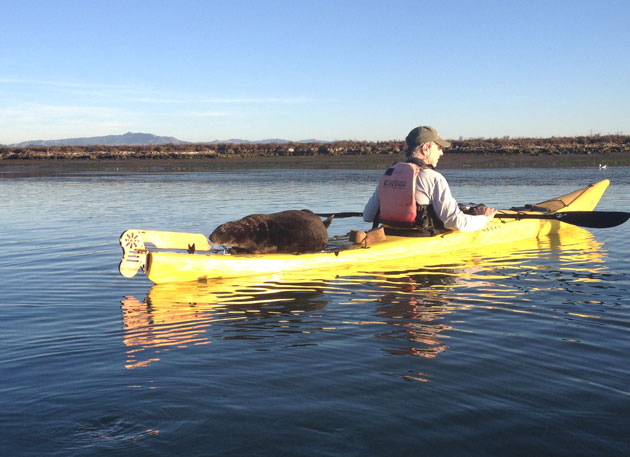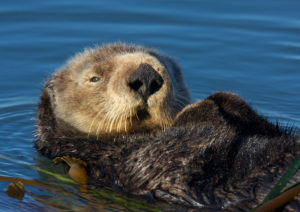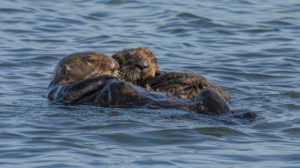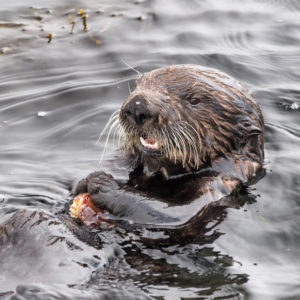ometimes you head out to a beautiful park or preserve and have a great time enjoying the views and exercise and open air. But despite all those inviting acres of open space, you hardly see any wildlife at all. What’s with that?
On the other hand, some places just seem to be wildlife magnets. And one of those would have to be Elkhorn Slough near Moss Landing on Monterey Bay. You’re almost guaranteed to see lots of shorebirds, water fowl, and marine mammals almost any time of year. So why don’t I go more often? I don’t know; maybe because it’s a just a little long for a day trip (just over two hours each way from Berkeley), but too near for a vacation? Poor excuses, and I won’t accept them going forward.
I finally managed to return to Elkhorn recently, after a four-year absence. As you know we’ve been enjoying sinfully beautiful weather for the past two months, and Sunday, Dec. 30 was no exception. We were on the water in our rented kayaks by noon, and paddled past the lying-room-only crowd of sea lions draped all over the rip-rap of the marina breakwater, then slipped under the Highway One bridge into the slough. The mouth of the slough is wide and on this warm, sunny, windless holiday weekend afternoon, it was full of folks in kayaks and canoes. But you only need to paddle a little further up into the estuary (against the ebb tide if necessary), and the waterway starts to narrows a little, the traffic thins out, and the human and car noises slip away, and the wildlife takes over. Great egrets and great blue herons were feeding in the huge eel grass beds, their feet barely sinking in the great green mats of these important habitat-creating plants. Numerous species of water fowl (scaup, bufflehead, western and eared grebes, common goldeneye, a few loons) swam in the deeper water of the slough, while scads of shorebirds (godwits, willets, dowitchers, whimbrels, sandpipers, avocets) fed busily along the muddy shallows and in the eel grass beds.
But the main attraction of Elkhorn Slough is the marine mammals, and in particular, the southern sea otters. For sure, harbor seals are cute and curious, and there were dozens of them hauled out on a mud bar on the north side of the slough. But I can see harbor seals in San Francisco Bay any day of the week. So it’s the sea otters that are the stars of the show in the slough.
As an editor of a more-or-less serious nature publication, I do my best to stay away from anthropormorphizing animals or swooning over them. But, damn it, there’s just no way to look at sea otters and not think they’re incredibly cute. There were individuals and small groups in the water as we paddled upstream into the slough, but about a mile and a half in, there was a large group of them, resting in an extensive eel grass bed lining the north side of the slough.
Now this is a nature refuge, a sanctuary, and the rules say you’re supposed stay far enough away from the marine mammals so as not to affect their behavior. But these are curious critters and well aware of their surroundings, and they know we’re here. And these otters in the slough seem pretty well adapted to human presence. So even if you maintain a respectful distance, that doesn’t stop them from approaching you. So the protocol, as I understand it, is to stop paddling and let the animal do its thing.
And that’s exactly what we did when we came upon an otter playing in the water, twirling around in a kind of corkscrew fashion. My girlfriend Diane was in the process of taking a video of this playful behavior when the otter started swimming toward my boat. I kept still and watched, thinking “Oh, how cool, how cute!” as it swam closer to my kayak… until Diane exclaimed something like “Oh my god, it’s climbing on to your boat!”, and in one smooth motion, it propelled itself out of the water on to the back deck of my kayak!
Video by Diane Poslosky
Oh great! Now what do I do!?!? I didn’t dare turn around to look at it, because I needed to stay balanced and brace the boat to keep it from tipping over. I mean, sea otters are built to swim in Elkhorn Slough but I’m not! Diane was laughing and shouting “Don’t move; don’t move,” though I’m still not sure if that was so I wouldn’t tip over, or so she could get a better picture of the scene. Of course, sea otters have very sharp teeth and powerful feet, so I was in no hurry to “rock the boat,” as it were. And the otter itself seemed to be in no hurry to get off. And to make it all stranger, even though the otter was within six inches of me, I couldn’t see it.

Another kayaker, Kirkland Smidt from Santa Cruz, saw the developing encounter from a distance and came up to witness the show and started taking photos.
Finally Diane paddled over and gently came alongside my boat, which appeared to convince my otter passenger that it was time to off-board. It slid off but then swam over to Diane’s boat and pulled itself halfway out of the water to check out her back hatch cover. But Diane skillfully paddled away before the otter could climb all the way aboard her boat, as did Kirkland when the otter tried to board his boat as well. Laughing, we pointed our kayaks west toward the mouth of the slough, leaving the overly-friendly otter and the encounter behind.
It was all very amusing, especially once it was clear that I wasn’t going to have to swim with otters. But I’m not sure it’s a great thing that the otters are so habituated to humans that they will climb up on our kayaks. Of course it’s great that humans aren’t killing sea otters any more, and are protecting them instead. So it’s not all bad that they no longer see us as a threat. But interspecies mingling is probably not a great idea for either species.
Afterwards, I called up a sea otter expert, Karl Mayer of the Sea Otter Research and Conservation (SORAC) program at the Monterey Bay Aquarium, to ask about this encounter. According to Mayer, while not common, this is not unheard-of behavior for sea otters, particularly those in Elkhorn Slough and along Cannery Row in Monterey, where these naturally curious animals have become quite habituated to humans. “People in kayaks are part of their environment, and [the otters] have learned not to be afraid of us,” he told me. And different otters have different personalities, so some are just naturally more precocious than others. In addition, there are quite a few otters that have been rehabilitated and released, and they’re even less likely to be afraid of humans.
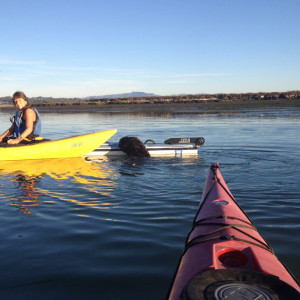
However, Mayer cautions that these are wild animals, with sharp teeth, and it’s impossible to tell what might trigger an aggressive response. He hasn’t heard of anyone in a kayak being attacked by an otter, but it’s not out of the question if these encounters become more common. So if you’re approached by an otter in this fashion, Mayer’s advice is to use your paddle to gently fend off the animal and then paddle away, to discourage it from climbing aboard, and if it does get on board, you want to encourage it to get off. But Mayer acknowledges that’s not necessarily so easy to do without jeopardizing your stability. My advice: Have a companion come over and give the animal a nudge. I guess I was fortunate to have a friend along, or else it could have been a very long afternoon!

